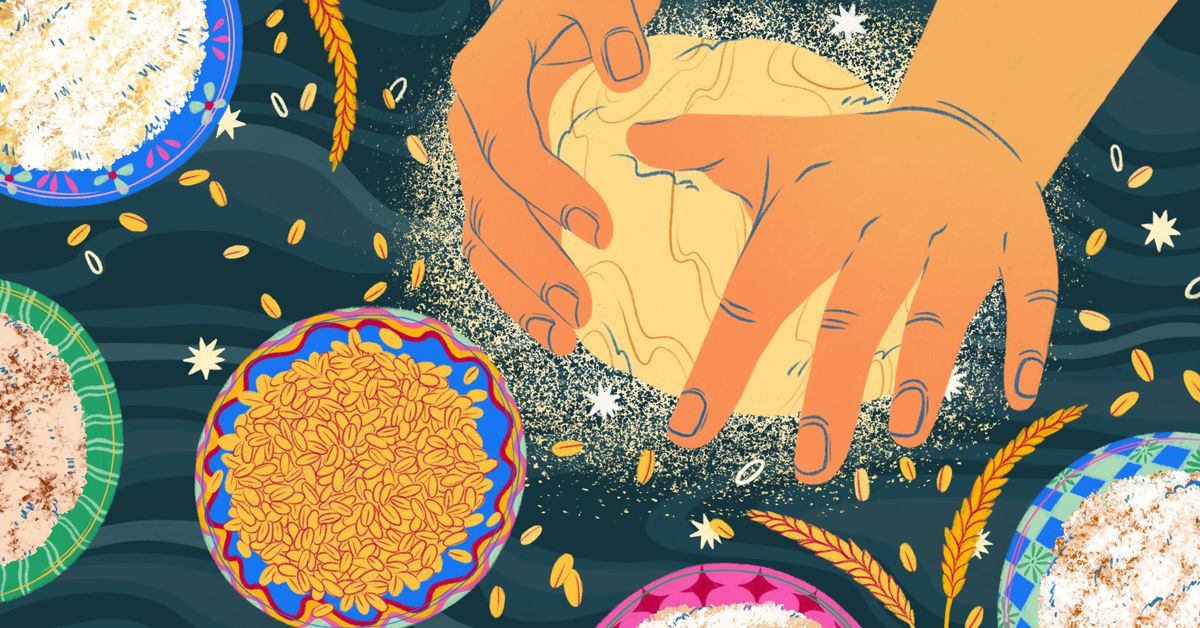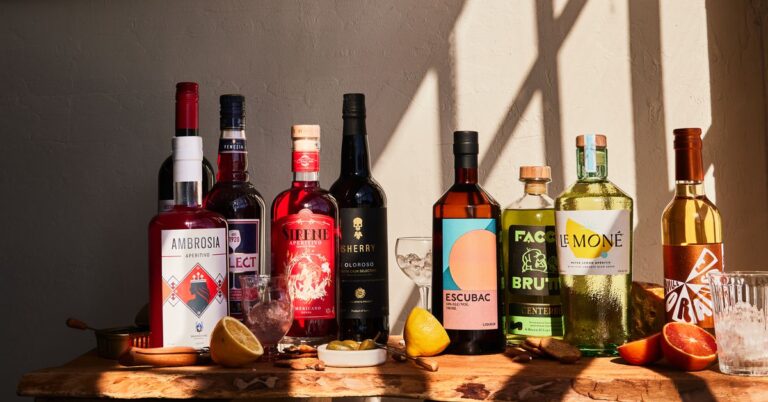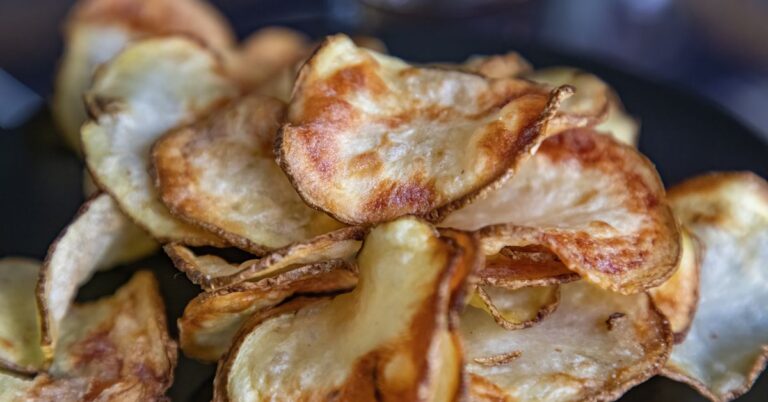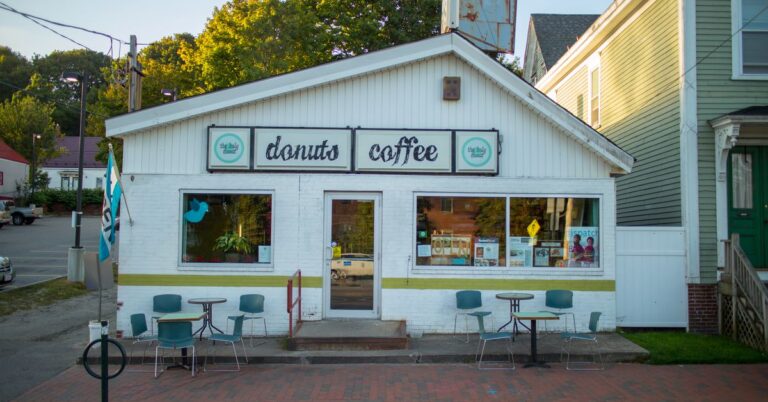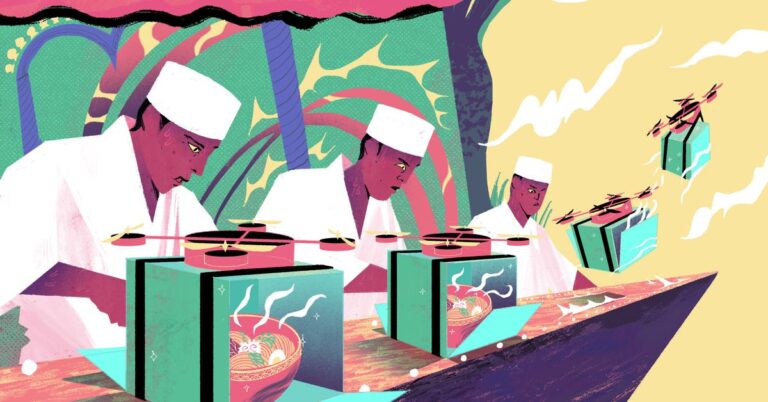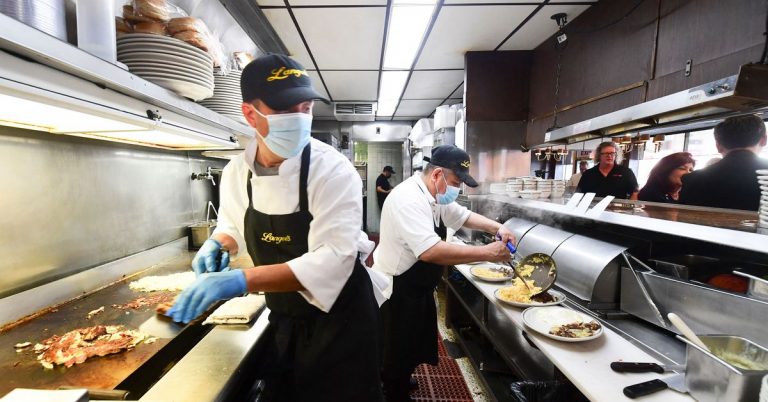The Differences Between Processed White Flour and Whole Grain Flour
Where were you during the great bread baking boom of 2020? Me, I was cleaning out a trash can full of dog food to make room for 50 pounds of flour.
The trash can belonged to Ziggy, my family’s late dearly beloved chihuahua (may he rest in peace), but at the height of the first COVID crisis in August, I needed somewhere to store the flour I’d ordered from a wholesale bakers outlet. Ziggy would understand, I reasoned, so I dumped the kibble, hosed down the can, and lined it with a trash bag. In went the white stuff, a flurry of particles clouding around me like a halo.
A store of flour weighing as much as a small child felt necessary then: No one knew how long the pandemic would last (a long time, still ongoing, maybe forever), and for the many (the many, many) who had taken up baking in March and April of 2020, tentative forays into bread-making had evolved into full-blown lifestyles. As a result, the demand for flour exploded, and by summer, access to a product that had previously seemed as pedestrian and ubiquitous on grocery store shelves as cornflakes and ketchup — and which typically costs under about 50 cents a pound and was designed to last forever — became tenuous at best. At King Arthur, the brand that became synonymous with the millions of sourdough loaves baked during the pandemic, business boomed: In 2019, it sold 23.7 million 5-pound bags of flour to consumers; it sold nearly double that between April and November 2020 alone.
Long before I acquired my wholesale hoard, though, I had bought myself some break-glass-in-case-of-emergency flour. In the fridge, tucked behind a head of purple cabbage and next to a few cans of beer, was a small, clear bag from Castle Valley, a local stone mill located in Bucks County, Pennsylvania. “Refrigerate or freeze,” the bag read, with an expiration date of six months.
Inside the bag in the fridge was 10 pounds of bolted (or sifted) hard wheat flour with a creamy buttermilk color, slightly textured to the touch. Made with local wheat, it cost me $19, or $1.90 a pound, three times as much as the trash can flour. I had been buying this kind of flour from Castle Valley for a little over a year, ever since I started thinking about the flour that I put in my bread and where exactly it had come from. It was flavorful, it had personality, and it had an earthier look and feel than the flour in my trash can — it wasn’t bland and white. But I also couldn’t quite explain what made it different.
A few months before the pandemic began, a friend sheepishly admitted to me that she didn’t know how flour was made. At the time, even as a dedicated hobbyist baker, I didn’t really either.
Advocates for whole grains and the special whole wheat flour they produce have been saying that it is better for us in every single way — for our health, for our regional grain economies, for food equity, taste, and more — for decades, and yet all it took was a global pandemic to really start asking what that meant. After more than two years of touching grain, meeting millers, baking near-constantly, and seeing how the flour sausage gets made, I had learned how alienated the average home baker is from flour as an ingredient. The trash can flour was what most people, me included, were used to — the inert white powder — and the fridge flour was specialty stuff for those who could afford it. At least, that was the simple distinction I had accepted as truth.
Yet here many of us were, in the depths of a pandemic a few months into 2020, making crispy, airy bread loaves with crunchy brown crusts. Two years have passed since that first baking frenzy began — are we any closer to knowing what those loaves are made from?
On the hard mat of a moist gym floor in Darmstadt, Germany, Wolfgang Mock, the 75-year-old founder of Mockmill, was teaching me a lesson in the merit of whole grains: With a balanced diet centered around freshly milled, stone-ground flour, you too could be in your mid-70s, throwing jabs and holding planks in a Krav Maga class, your sweat-slicked muscles on proud display in short shorts as you outmaneuver your millennial competitors. That night, he forwent the after-class drinks in favor of relaxing at the compound where he lives with his family and several others — let’s call it commune lite — to talk with me over a glass of wine, one of his few worldly indulgences. The topic? Why whole grains are the solution to many of the health problems plaguing the Western world.
Mock is a youthful septuagenarian, with enormous steel blue eyes, a bald pate, and the no-nonsense energy of a health fanatic who happens to be a German man. The company he founded and has since left produces countertop mills, which, much like grinding coffee beans right before brewing, allow bakers to make fresh flour from grains on demand: Whole grains and pulses — like wheat or rye berries, chickpeas, beans, or really any hard seed of your choosing — go in, flour comes out. Fresh flour, milled right at home, has two benefits, Mock told me: The nutrients present in the whole grain aren’t spoiled from sitting on a shelf, and because whole seeds are shelf-stable basically forever (or at least up to a year), one could make fresh flour whenever they wanted.
:no_upscale()/cdn.vox-cdn.com/uploads/chorus_asset/file/23223539/NMedina_Grain_Spot_3_.png)
Though tabletop mills are not uncommon in Germany, Mock hoped to make his mills (or really, any mill, he says) a staple in American kitchens, too. (Mock now runs a company called Mockbake, through which he sells whole grain kitchen tools like oat flakers.) “I think most people — nearly all the people — want to live healthy and be strong and be in good shape, and they don’t know how to do that,” he said. “Many, many people in America, even in Europe, they spend a lot of money every month to buy [vitamins]. They think they are healthier if they buy that.”
The problem with the Western diet, Mock said, is that all the wholesome foods we need are right in front of us, but we default to lazy shortcuts — like vitamins and smoothies and processed “health” foods — that don’t actually nourish us. “It was only six or seven generations ago [that the flour we use now was developed], and nowadays people think that that’s grain. They do not know about grains.” When people think of grains, Mock said, they think white flour.
“[People] want the vegetables fresh. They want the salad fresh … They even bring fresh roses back home,” Mock said. So why do we settle for purified enriched white flour that’s been languishing on the shelf? As a result of his whole-grain lifestyle, Mock said, “I noticed in the last few years, I could drive my car without my glasses.” Though “not at night,” he added.
The industrial commodity flour business, Mock said, is like a big steamer ship. “The bigger the ship, the longer they need to turn.” Even the white flour millions of people bought from artisan brands like King Arthur in 2020 would not pass Mock’s sniff test, as almost all commodity all-purpose white flour is not — by necessity — made with the whole grain. (In order to make finer white flour, the darker and more nutritious parts of the grain have to be sifted out.) A flour using only part of the grain is simply not good enough for Mock — what good is a grain if it isn’t whole?
A whole grain is technically an edible seed harvested from grass. There are about 12,000 species of grasses in the Poaceae plant family, countless of which produce grains that humans have cultivated for consumption. For the purposes of this piece, we’re primarily talking about wheat. There are three important parts of a wheat grain: the bran, the endosperm, and the germ. Bran is the outermost layer, full of fiber and vitamin B, while the endosperm represents the carbohydrates and starchy parts of the grain; the germ contains the highest percentage of nutrients in the form of minerals, vitamins, protein, and fats. Whole grains, with all their components intact, give us energy and keep us full.
Once early humans discovered cereal grains, they knew they were onto something. That’s because grains provided two benefits that meat and plants couldn’t: Not only were they packed with nutrients and energy, they came with a natural packaging that made them largely shelf-stable. The grains by themselves were too hard on our ancestors’ digestive systems (not to mention teeth) to break down, so humans developed rudimentary stone systems to crush and grind the living hell out of grains in order to get to the much more valuable nutrients on the inside. Like otters beating clam shells with rocks, we did our best. Flour was just a pulverized version of seed, which we mixed with water and baked in a slapdash fashion.
The very earliest “mills’’ were developed to exploit this discovery over 75,000 years ago and although their crude grinding stripped the seeds of much of their nutrition, we’ve never stopped looking for new and less labor-intensive ways to grow and process the stuff we call grain. Until the industrial revolution, progress was best counted in millennia and centuries. For thousands of years, women were the ones frequently consigned to hands and knees to push grain over rudimentary saddle stones. The invention of the quernstone around 9000 BCE, where one stationary stone sits beneath a rotating stone above it, with complementary grooves between them to encourage better grinding, was one of the bigger steps toward progress for our species.
By the 18th century, mills occupied whole buildings, but running a mill still required a great deal of skilled human labor. Walter Dorwin Teague’s 1952 book Flour For Man’s Bread: A History of Milling summarizes inventor Oliver Evans’s reflections on milling during the pre-industrial period: “In an ordinary mill he noted that seven tasks were performed by hand — carrying in the wheat, hoisting it, taking it from the granary to the hopper, shoveling the grist into tubs, hoisting them, watching the bolter, and mixing the bolted material — either requiring seven workers or necessitating the stoppage of certain operations while others were being carried on.” Millers also had to be tuned into the quirks and pitfalls of their mills — early industrial machines — with the threat of mill fires and personal injury always looming.
In 1785, inventor Evans (no relation to me) was responsible for devising the first automated flour mill, which could run without an overwhelming amount of human intervention, making it easier to ramp up production as the U.S. expanded and wheat was being cultivated on land unfamiliar to the colonizers occupying Indigenous land. “We did so much production in the Northeast at the beginning [of the United States],” Amy Halloran, author of The New Bread Basket, told me. “The Dutch saw, ‘Hey, this is a great place to grow grains for other colonies, so in Westchester County at the Van Cortlandt Manor, they had 21 flour mills.” Over the next century, regional grain economies thrived across the growing country, supported by local mills, farms, and bakeries. America entered a golden age of bread and flour production, with fresh flour milled by local millers, often using wheat that had distinct regional qualities dependent on local weather patterns, soil, breeds, and seasons. The quality of the flour wasn’t nearly as standardized as it is now, which could translate to a variable consistency, but flour back then was full of regional nuance and made with individual skill.
Then the roller mill crashed onto the scene. Invented in Hungary and Switzerland in the early 1800s, it found its way to America in the late 1800s, and it was exactly the solution the nation needed to standardize and revolutionize flour production. Unlike a stone mill, which grinds the whole grain into flour without splitting apart the grain’s components, roller mills split the endosperm from the bran and the germ, making two separate products. Separating the grain, passing specific parts through the mill again, and sifting makes a flour that is consistent to bake with, less prone to spoilage from containing a lower percentage of the oily part of the grain, and a lighter color for breads, cakes, and desserts (which made it more attractive to the wealthy). Flour could be shipped internationally and kept for much longer periods of time, which meant an exponentially greater output was possible.
:no_upscale()/cdn.vox-cdn.com/uploads/chorus_asset/file/23223532/NMedina_Grain_Spot_2.png)
Previously finicky local stone mills with skilled laborers at the helm producing flour of inconsistent qualities fell out of favor. Before long, large-scale industrialization and centralization of flour production disrupted the U.S.’s thriving local grain economies: In 1860, there were 13,800 mills in America. In 1912, about twenty years after the introduction of the roller mill to America, the number of mills in the U.S. had been reduced by roughly half, to 7,831 commercial flour mills. Commercial bakers began to demand flour made from roller mills, as that flour — compared to the variable stuff made on stone mills — helped provide a more consistent, stable product. What was once a community-supported craft became industrialized into anonymity.
“[Flour milling] became a thoroughly mechanized, large-scale industry, drawing its ever more varied wheats from ever more distant sources, submitting them to a cleaning and reduction program whose broad outlines were thoroughly standardized,” writes Teague, “producing flours and feeds of remarkable purity and uniformity, and disposing of a constantly increasing volume of production in ever expanding markets.” These standards have been present in America ever since.
While we can celebrate the advancements of industry that made grinding and transporting wheat a consistent and predictable task, it has cost us: Ever more alienated from the ingredients that make up our food, roller-milled commodity white flour rendered farmers, millers, and bakers faceless and nameless. And that pure white flour frequently isn’t nourishing, either. The whiteness is a result of removing the bran and germ entirely — and with certain brands, often bleaching and bromating (a process of treating flour to improve elasticity and produce a higher rise in baked goods). Because commodity white flour is so “purified” by the industrial milling process, the FDA requires big flour companies to fortify certain white flours after the fact with additional nutrients and vitamins, even though grain when it’s milled whole is itself naturally nutrient-dense.
Industrially produced whole wheat flour is a little more complicated. Jeff Yankellow, director of bakery foodservice sales at King Arthur Baking Company, told me that their whole wheat flour — despite being made on an industrial roller mill — is no different than stone-ground whole wheat flour. “You put a hundred pounds of grain into a mill, a hundred pounds [of flour] come out,” he said, explaining that the King Arthur whole wheat flour is exactly what the name implies: the wheat grain is kept whole. “As a company, our whole wheat flour is never enriched because the nutrients are already there,” Yankellow explained. The browner, textured fridge flour I used was also called whole wheat flour, but Yankellow told me that the coarser texture comes down to technique and mill. “You could run flour on a stone mill that could be finer or coarser. You could run flour on a roller mill, it could be finer or coarser.”
“There’s a lot of speculation about what other companies are doing,” Yankellow said. “If you look at the definition of whole wheat flour on the government website, it has to be 100 percent whole grain. I don’t see how any company gets away with selling the flour without all its parts back in it.”
Since the germ and the bran contain fats and oils, even if they are reintroduced to the white flour after being milled on an industrial roller mill (thus making whole wheat flour), there are questions in the whole-grain community about how the purity and fineness found in those whole wheat flours actually maintain the nutritious wholesomeness of the grain without spoilage. One 2020 study in the Journal of Food Science commissioned by Community Grains, an Oakland-based miller, looked at a sample of grocery store flours labeled as whole wheat and found that they contained up to 40 percent less of a certain whole wheat protein than the 100 percent whole grain standard.
“I think that we’ve so desensitized people, really removing people’s reliance on their own senses,” Mai Nguyen, a farmer in California, told me. When Nguyen opens a bag of stone-ground whole-grain flour, they “can smell the different flavors.” When they open a bag of commodity flour, “I can smell in there that there’s nothing.”
Nguyen continued: “What does it mean to be a modern-day eater when people aren’t really growing their own food or interacting with any kind of natural cycles and production? So much is processed through this really long commodity chain. What do you really know?”
In what now feels like an entire lifetime ago, many months before the pandemic, I was driving down a dirt road in Scotland, beating up a pristine rental car in search of some hard, Scottish-grown, straight-from-the earth, whole-ass grains. My first experience driving on the left side of the road had not been going well. High winds from the nearby North Sea shook the car, while the muddy paths that my GPS sent me down were only making driving Scot-style harder.
Eventually I pulled up to a gatehouse in Anstruther, windswept and muddy, where I was greeted by Connie Hunter over the reverberating beating sound of her silver Zentrofan cyclone mill. The machine looked to me like the tornado-tracking machine built by the bad guys in the movie Twister — silver and circular with a metal funnel directed into the space — and it was shuffling grain and loudly sputtering out flour in her small warehouse. Hunter is the miller for Scotland The Bread, a nonprofit whose mission is “to grow better grain and bake better bread with the common purposes of nourishment, sustainability, and food sovereignty.”
As Hunter and I spoke, she climbed up and around industrial-sized jute bags that seemed to fill every available corner of the small space, each stuffed to the brim with speckled, caramel-colored wheat grains. She shoveled them out with a large yellow plastic scoop, plucking pebbles and other impurities from the grains she handed to me to inspect. The small, hard, compact grains felt just like rice or corn. I wanted to touch grain grown in Scotland seconds before it became flour milled in Scotland. I was searching for a physical manifestation of the power of flour.
Hunter was the first miller I had ever met, and seeing her at work was the first time I saw how the proverbial sausage — the flour I had been baking with for years — was made. She scooped grain from a bag, stood on a step ladder, poured it into that Twister-looking robot, and it shuffled through the machine until it came out as textured brown flour into another bag. “We only sell wholemeal flour because we went to all this effort to find the most nutritious grains and mill it in the most nutritious way possible,” Hunter said. The flour she had milled in front of me would go right into a bag for sale.
“Most people just think flour is this inert substance that you can have in the back of your cupboard for months,” Hunter said. “We always give our flour a three-month best-before date. Obviously, it’s fine after that.” But fresh flour with all the component parts was the ideal, she explained, which is why when bags of white flour on grocery store shelves started to run out during the pandemic, companies like Scotland The Bread suddenly had the eager attention of consumers.
In 2020, major flour companies couldn’t keep up with the demand of the legions of new home bakers, so many bakers turned to small local mills, making artisan bread flour on stone mills, to order flour. “The [flour] that cannot be replaced speedily is the stuff that’s coming from the big millers because everything is so massive and centralized,” Monica Spiller, founder of the Whole Grain Connection, a nonprofit organization that advocates for and promotes the usage of whole grains, told me about pandemic flour-purchasing. “So the people who are filling the gap are all these small millers that have sprung up. They’re the ones who were supplying flour to people during the pandemic.”
My break-in-case-of-emergency flour came from Castle Valley Mill in Pennsylvania. That flour produced much different breads than I was used to, with powerful flavors and interesting textures. It was confusing to me at first — I had no idea how to actually bake with it — but buying it was a bulwark against the pandemic-induced scarcity that we were all experiencing. When I realized the mill I had bought the flour from was a 30-minute drive from my house, I saw another opportunity to get to know my flour in the most local way possible. It was time to meet not just any miller — but my miller.
Over the rushing sound of the Neshaminy Creek, on an icy but bright day in December 2020, Fran Fischer showed me a 200-year-old millstone that her family had recently unearthed in the creek. It appeared to have been cracked during use, and its unwieldy shape made it look prehistoric. She pointed out a teenage bald eagle flying overhead that had recently gotten trapped inside their chicken coop.
What year was it again?
Fischer and her husband Mark, along with their kids, own and run Castle Valley, which has been in Mark’s family for three-quarters of a century. Their milling is still done with several cleaning apparatuses and stones that grind against each other, using wheat grown in Pennsylvania. One type of flour they offer is sifted so that it kind of looks like white flour and is meant to be used in place of traditional bread flour, but for the heartier varieties they sell, none of the parts of the grain are sifted at all. (In the baking world, this is called 100 percent extraction flour.) The small warehouse room I had visited in Scotland felt both tiny and highly advanced in comparison to Castle Valley’s: The floors of its three-story mill building were all creaky wood, and much of the machinery dates back to the late 19th century. “It works like a charm,” Mark said, pointing at one of many pieces of grain-cleaning equipment in the building. Mark, who has a background in aviation, put the equipment for his stone mill together by going to the patent office and referring to documents from two centuries ago. It took years.
Fran leaned in to me. “I call it ‘forensic milling.’”
:no_upscale()/cdn.vox-cdn.com/uploads/chorus_asset/file/23223504/NMedina_Grain_Spot_1_V2.png)
The Fischers had agreed to give me a tour of their mill when I had asked what it was like to be one of the few small mills in America that took off in 2020 as commodity flour started to sell out at grocery stores. While we walked around the property, Mark Fischer pointed out his 4,000-bushel grain bin, which seemed huge to me. On the scale of farms, this is teeny-weeny stuff, Fischer explained. “A kid who worked here, his parents had a farm, they had 125,000-bushel bins everywhere. But … for the scale that we’re operating at, this is good.”
Or, at least, it’s good now. In March 2020, when COVID-19 hit, the Fischers had just taken out a loan to help sort out some of the production changes they wanted to make. They didn’t panic, even as the restaurants they sold flour to started shutting down; they figured they’d live off the loan until things got back to normal. Then one of their wholesale distributors called begging them to take the flour back, which they did. “And then we sold it overnight,” Fran said.
The family worked together to get the flour to consumers day and night. [We had] head-to-toe bruises because we’re loading boxes. We had the big carts that we push around,” Fran recalled. “We were working so fast, we ate standing up. I would make something in a pot and I’d come out with three forks. It was not good.” There was a lot of education involved, which was time-consuming: People who had never baked with stone-ground flour questioned the way it acted when it was mixed into dough (why did it suck up so much water?), its smell (hay), and its taste (healthy). The fact that the flour had to be refrigerated was confusing enough on its own.
This was a time of fast learning for a lot of American consumers, with a lot of information to sift through. Was brown flour always better? Was fresh flour the most important? Were commercial brands always evil? Many people evolved past the question of “How is flour made?” to “How do I want my flour to be made?”
Yankellow told me that a good part of what King Arthur does is educate consumers about flour — but once people got turned on to the idea that commodity flour is bad and local, small-batch flour is good, they began to encounter some issues. “We have a digital engagement team, they probably talk to those people the most,” Yankellow said, referring to customers who reach out wanting to know exactly how King Arthur’s flour is milled. “We just try to be honest and open. We don’t try to argue or debate … We try to base [the conversation] on facts and truth.”
For King Arthur, the concept of freshness — and its relative importance — is a complicated one. King Arthur’s flour has a 12-month expiration date, which isn’t Yankellow’s ideal. “In food service, we don’t want that at all. We want you to be using it within four to six weeks,” Yankellow said, but the reality is that their whole wheat flour will be fine if used within a year. It wasn’t sustainable to expect consumers would use their flour immediately after buying it. That is, until the pandemic happened.
In the sea of people with opinions about flour, they’re all experiencing at least one thing in common: Consumers are asking more questions.
People ask how they can support local agriculture, Mark Fischer said, but for some reason that thinking used to stop with flour. “Can I buy local chicken? Can I buy local honey? But nobody is thinking local flour. Flour has just always been there,” he said. “‘It’s a commodity. It’s nothing special.’” The Fischers working at a back-breaking pace to get flour to people who had never even thought about it wasn’t the ideal — the ideal was people looking into their regional grain economies and supporting those local mills in the long term.
Over email, in between production, Nan Kohler of Grist and Toll, the first urban mill in LA in almost 100 years, shared what the pandemic had taught her about our relationship to commodity flour. “It is pretty clear that even with such a long history of dominance in the production of cheap, industrial food, we certainly aren’t feeling much food security these days.” One global crisis was enough to prove that many of the systems we rely upon are dangerously fragile. “More regional control could give some of that [security] back. Industrial systems can’t adapt quickly. Smaller businesses like mine can, but we lack the supporting infrastructure right now. We really need capital investment and government policy changes to help us put some of that back into place.”
Among the many questions being asked of millers — big and small — about flour, there is one on the tips of our tongues: If this special flour full of wholesome whole grains is $19 for a 10-pound bag, who can really afford it?
In the middle of all this reporting, I somehow ran out of the trash can flour. I was staying with friends for the weekend and I needed to have bread with us in the house. (A house is not a home if there isn’t bread in it is something I imagine an embroidered pillow would say.) Though it pained me to use up so much of the expensive flour that I kept in my fridge, I had little time and the bread simply had to be made.
Using my go-to sourdough recipe, I mixed dough with the fridge flour alone, baked it up, and brought it with me. When we ate slices of it with just a little butter, my friend asked if I had added cinnamon to the dough. I hadn’t. The taste had come from the unfiltered, unprocessed whole wheat flour. When I asked Fischer about that taste, he confirmed that the flour did have a warm, spicy flavor — it had come from the wheat. “This year, the hard wheat that everybody grew had a little bit of a cinnamon smell to it,” he explained. “It’s just the variety, the climate, the water, the soil, it’s what happened this year. Last year it didn’t taste like cinnamon. Next year maybe it’ll taste like lemon. It’s in your dirt, it’s in your environment.” The flour, as a result, was special.
Advocates in the whole-grain movement point to research that whole-grain flour is more nutritious than products made with white flour; that whole-grain foods are more filling and are easily digested by people with gluten sensitivities; that the flavor, the taste, the every little thing is better with non-commodity flour. But those arguments can sometimes sound incredulous — why do people choose to eat unhealthy white flour when they could eat whole grains? — pathologizing communities to whom ingredients like stone-ground local flour aren’t always accessible.
Throughout the pandemic, Fresh Roberson, a Black chef and activist, has done work on getting whole grains and non-commodity flour to communities where they haven’t always been available. “People who are thinking about it’s important to eat local aren’t thinking about this neighborhood that doesn’t have access to local,” Roberson, a resident of Chicago’s South Side, told me. To me, it just seems like the cycle of how things go is like you get the neighborhood and the folks who have more privilege [first] … And then there’s often the charity mindset, ‘Oh, these people that don’t have it should maybe also have it.’”
The conversation around access to more nutritious — but typically more expensive — flour is happening when food insecurity has skyrocketed. How fair is it to expect a world where all wheat is grown and milled into flour regionally when 23.5 million Americans still live under food apartheid? When, in 2020, four in 10 Americans visited food banks for the first time? If the goal of the grain revolution is a more local, sustainable, and accessible agriculture, that requires reaching beyond privileged communities filled with bakers newly taken with making bread — it requires interrogating the preexisting system, and who is granted access to wholesome foods in the first place.
“Right now, if I look at each segment of the grain chain [in my region] — growers, millers, distillers, brewers, bakers, all of these folks — most of those people are white. Anybody who is a supplier in the market in a major way is definitely white,” Roberson said. “What does it look like for other folks to have access to that? What does it look like to create spaces where other people have access to growing, to milling, to brewing, distilling, and being able to have access to that knowledge?” Equity and access is important, especially when it comes to envisioning what a farmer even looks like. “[Farmers] aren’t just white men on tractors with vast thousands of acres of land. That’s who you see when you think about grain farmers,” Roberson said.
But when we think about grain, Roberson added, we can’t only think about it in terms of the commodity market. We have to think small and local, which means taking a “love thy neighbor as thyself” approach. If I get to bake with local flour, so should everyone else. Whole-grain flours need to be accessible in local markets, so they can be purchased with EBT cards, Roberson said. “Figure out what it was that people like the most” and make it available. This also means considering cultural preference for non-wheat grains like freshly milled corn or teff. It also means not passing judgment when folks decide they’d rather bake or cook with the flour that is readily available to them on the grocery store shelf.
The conversation around choosing whole grains for health reasons can also stigmatize people for how they look, rather than how they feel. Roberson is occasionally confronted with the questions around how we promote whole grain for “health,” which can be a personal concept. “It’s so hard because it’s so ingrained in our culture to think that this is an acceptable thing, to have this universal idea of what healthy means,” Roberson explained. “How do you make your case, how do you support people, and tell people why this thing is great without having to tear anybody down?”
If you love the flavor of whole grain, everyone should have the option to use it. It shouldn’t be more complicated than that.
That’s why people like farmer Mai Nguyen, who partnered with miller Nan Kohler to sell the grain they grow in a flour CSA, have used their own upbringing as a model for how to address grain equity. “Coming from a background of being a child of refugees, I’ve just been like, ‘Why don’t we have our basic needs met?’ When we pay for food … it better feed us. There’s no time for B.S.,” Nguyen told me by phone. “Anything that we have, it should stretch. It should cover. It should be nutrient-dense.”
Nguyen said they reread the Declaration of Independence several times in 2021. “It clearly states that the government’s number one role is our safety,” Nguyen said. “There is the local food promotion program where every year thousands of regional food system people submit grants. They’re just like, please help us. We know what is needed to have the right cooler system and connections to our local farmers and eaters and to break down food apartheid. It’s all there. I know it’s not a popular thing to say, but the way that large-scale change happens is for a government to get behind it.”
For the Whole Grain Connection’s Monica Spiller, the ideal path is investing in milling infrastructure and designing an alternate to the commodity system. “The key next step is that the grain is stored locally and distributed locally. And we need a lot of mills,” she said. “The restaurants and the food service people and homes, everybody should have a mill available to do small-scale milling from the grain as an automatic thing. And the big bakers [should] be located next to the bigger mill locally, getting their grain locally from the big storage locally.”
Farmers need subsidies and infrastructure; millers need the same, as well as local support, a loyal customer base, and strong relationships with farmers; bakers need consistent and approachable flours to bake consistent and approachable goods for their consumers; home bakers need a little bit of everything, but most of all access to fairly priced flour regardless of their income status. It’s hard to imagine how all these needs can be met. “I think the niche of fresh flour is expanding,” Halloran told me, “but it’s tough to say how far it can [expand], given the differences in scale and price supports that keep costs of commodity products so low.”
But maybe it is possible, if we just make an effort to care. That requires consumers who are able to begin investing in our local grain economies, baking with regional flour, and learning who our millers are. Roxana Jullapat, owner of Friends & Family Bakery in Los Angeles and author of the cookbook Mother Grains, dreams of walking into any grocery store and seeing a flour aisle as big and varied as the cereal aisle. “That’s my 10-year plan,” she said. “That is another food policy decision or answer. It’s not one baker’s responsibility … We want to see the USDA and even the local health departments encourage this kind of business.”
For Nguyen, accountability in our grain system is everyone’s responsibility, but most of all those at the top. “The federal government invested in the infrastructure for big ag through the Farm Bill and other USDA programs … The federal government could, too, expand investment in regional food infrastructure,” Nguyen said in a follow-up email. “These are reasons to carefully select our federal representatives and end the filibuster. People say the government moves slowly, but we can see that it can be swift to bail out airlines and separate families,” they said. “Public investment in the roads and means to connect people to local food would greatly reduce cost of production and make wholesome grains widely available and affordable.”
There is a way to do these things — to make locally milled flour available and accessible, Nguyen said. “We just need public will.”
Two extremely long years after I started reporting this story, I sent a self-addressed stamped envelope to the SQFT Project, care of an organization called the Northeast Grainshed Alliance. A few weeks later, in that same envelope, I received a small instructional packet and about a dozen wheat kernels, which slipped and slid all around like pinballs when I poured them into my hand. “You are receiving enough wheat berries to grow 1 SQFT of Hard Red Winter Wheat,” the packet said, alongside instructions on how and when to plant my grains.
I live in Philadelphia, so I don’t exactly have a massive field in which to grow wheat. My back patio is roughly 200 square feet, and the small patch of garden within it occupies barely a fifth of that space. But I could spare a square foot of soil if it meant that I could grow wheat — Philly wheat! — right in my backyard. I had no faith that it would actually work.
“Our vision is a Northeast grain-growing region with its own infrastructure and identity,” the SQFT Project packet began, “in which people understand the benefits of growing and eating local grains. Along with food and beverages made with local grains becoming mainstream and accessible to all.” Sure, I thought. I’ll give it a shot. I measured out a 12-by-12-inch square, dug the soil, and planted the seeds, fully expecting Philly squirrels to come dig them out for a tasty little snack within the hour.
In the dead of December 2021, I opened my back door to see how freezing cold it was about to be that day. In the corner of my eye, in a sea of brown and gray, I spotted something green. My wheat — my Philly wheat — was sprouting in a verdant lime color in an organized row of grasses, moving like, well, sheaves of wheat do in a stiff, cool breeze. The grasses were small, barely a few inches high, but they were growing.
“We still say ‘amber waves of grain’ but most of us don’t know what that looks like,” Amy Halloran had said to me a few years ago, when I first started really thinking about flour. Looking down at my square foot of green and growing wheat, inching upward toward the big sky, I now knew it very well. And I liked what I saw.
Nicole Medina is a Philly-based illustrator who loves capturing adventure through her art using bold colors and patterns.
Fact checked by Hanna Merzbach
